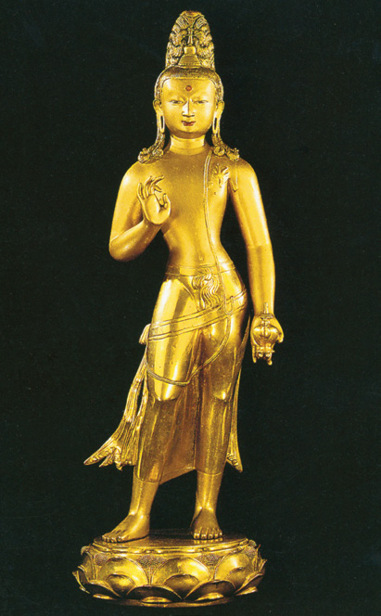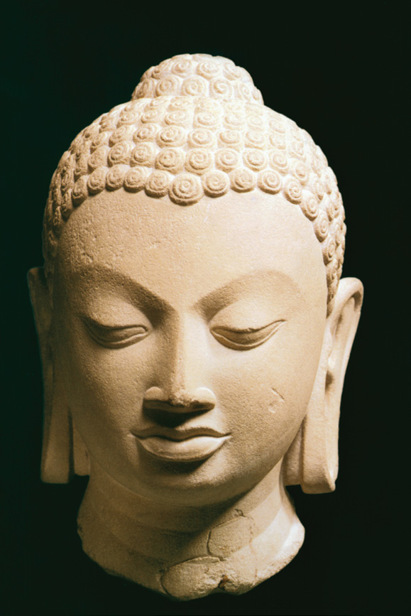An Illustrated Outline of Buddhism: The Essentials of Buddhist Spirituality (14 page)
Read An Illustrated Outline of Buddhism: The Essentials of Buddhist Spirituality Online
Authors: William Stoddart,Joseph A. Fitzgerald
Tags: #Philosophy


The Nature and the Teachings of Buddhism
35
The Four Noble Truths
(1) Suffering is universal.
(2) The cause of suffering is craving or selfish desire (
trishnā
).
(3) The cure for suffering is the elimination of craving.
(4) The way to achieve the elimination of craving is to follow
the Middle Way, the technique of which is described in the
Eightfold Path.
The Eightfold Path
(1) Right views
(Right understanding)
wisdom (
prajñā
) section
(2) Right intention
(3) Right speech
(4) Right conduct
morality (
shīla
) section
(5) Right livelihood
(6) Right effort
(7) Right mindfulness
realization (
samādhi
) section
(8) Right concentration
The Eightfold Path, with its three sections—“wisdom”, “realiza-
tion”, and “morality”—thus exemplifies the three elements that are
necessarily present in all religions: truth, spiritual way, and virtue.
Opposite page
:
T’hanka
of Amogasiddhi Buddha, Central Tibet, c. 1200-1250

36
An Illustrated Outline of Buddhism
The element “conduct” in the morality section is made explicit in
the practical code known as “The Five Precepts”.
The Five Precepts
(1) To abstain from the taking of life.
(2) To abstain from the taking of what is not given.
(3) To abstain from all illicit sexual activity.
(4) To abstain from lying.
(5) To abstain from intoxicants.
The doctrine of
karma
(“as a man sows, so shall he reap”), which is
integral to Hinduism, is also present in Buddhism. For further discus-
sion of
karma
,
“karmic continuity”, and the related doctrine of “rein-
carnation”, see pp. 123-125.
*
* *
Like virtual y every other religion, Buddhism sees mankind’s history as
a gradual, but accelerating, decline and envisages a forthcoming “end
of the world”, at which time the Buddha
will return as Maitreya Bud-
dha. A
similar apocalyptic expectation exists in Hinduism in the form
of the
Kalki-Avatāra
, and in Christianity and Islam in the form of the
second coming of Christ.
*
* *
The Supreme Buddha (
Ādi-Buddha
)
is said to have manifested Him-
self many times for the salvation of men. The
Buddhavamsa
(part of
the
Khuddaka Nikāya
)
lists ten manifestations of the
Ādi-Buddha
who
“turned the Wheel of the Law in a deer sanctuary”, eight of them pre-
ceding, and the tenth one (Maitreya)
following, Gautama.



The Nature and the Teachings of Buddhism
37
Standing Maitreya Buddha, Mongolia, early 18th century





The Nature and the Teachings of Buddhism
39
These ten Buddhas are as follows (names in Pali, with Sanskrit in
parentheses):
Dhammadassin
Siddhatta (Siddhārta)
Phussa
Vipassi (Vipashyin)
Sikhī (Shikin)
Kakusandha (Krakuchchanda)
Konāgamana (Kanakamuni)
Kassapa (Kāshyapa)
Gotama (Gautama) [the historical Buddha]
Metteyya (Maitreya) [the Buddha yet to come]
In Hinduism there are ten principal Incarnations (
Avatāra
s)
of the
God Vishnu. One may see a certain analogy between the Hindu and
Buddhist series of ten Incarnations: in each series, the second-last per-
sonage is precisely Gautama Buddha, and the last is the “apocalyptic”
Incarnation (Kalki
or Maitreya
respectively).
*
* *
Following the example of the Buddha himself, the final goal of the
Buddhist religion is the attainment of
Nirvāna
(the “Unconditioned”
or “Divine State”) from the starting-point of
samsāra
(the world)—in
other words, the attainment of the Absolute from the starting-point of
